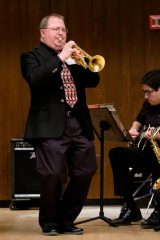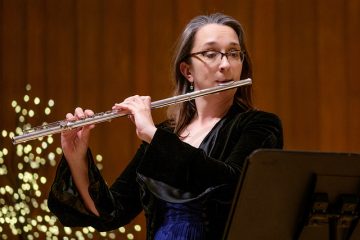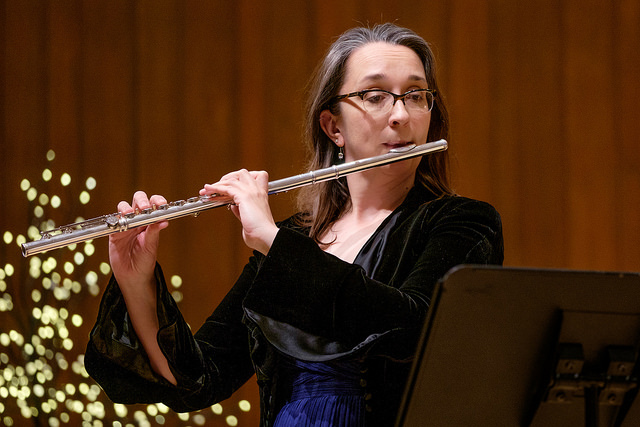Two University of Wisconsin Oshkosh music faculty members are hoping to hit all the right notes as they spend the semester deep in music research and development.
Marty Robinson, professor of trumpet and jazz; and Linda Pereksta, associate music professor who teaches flute, aural skills and chamber music, each have been awarded a sabbatical leave for the current spring 2018 semester.
 Composing jazz
Composing jazz
Robinson, who has been teaching music at UW Oshkosh for 14 years, will compose four original pieces for high school and collegiate level jazz ensembles. Although Robinson has experience arranging and composing pieces for professional level ensembles, this is relatively new territory for him.
“My hope is that my original voice as a jazz composer (and arranger) can be heard more in these new works which will have a good chance at national publication and performance,” Robinson said.
Robinson’s first stab at writing original music for the high school level came in 2016 when he was chosen to conduct the Wisconsin State Honors High School Jazz Ensemble. He took the opportunity to compose an original work titled, “Anachronism,” which the students then premiered. The piece currently is under consideration for publication.
“The four new original pieces from this sabbatical will hopefully follow on the heels of that work,” Robinson said.
He will begin the writing process this month by studying compositions that have been written for high school and college musicians. The months of March and April will be used for the music creation portion of the process, with the final drafts of the four pieces being completed in May.
“I’m confident that I have some new things to add to the current ‘sound’ in jazz composition, and that these new works will also showcase and recognize UW Oshkosh as a place where jazz is alive and well,” Robinson said.
 Creating reference guide
Creating reference guide
Pereksta, an accomplished member of the music faculty at UW Oshkosh, holds positions in many prestigious orchestras around the country, including her current role as the piccolo player in the Madison Symphony Orchestra.
During her sabbatical leave, Pereksta will compile and create a reference guide for musicians looking to embellish music based on the 12 “Methodical Sonatas,” written by Georg Philipp Telemann in the 18th century.
“My project is related to historical performance practice, which is an important facet of my professional work,” she said. “In the Baroque period, performers were expected to freely embellish the music they played, and my sabbatical project is related to the (teaching) materials that were created in the 18th century to help musicians become proficient in that skill.”
Pereksta is spending the first few weeks on her sabbatical doing an independent residency at the Banff Centre for Arts and Creativity in Alberta, Canada.
“It’s a perfect place to focus on this project, with great support and minimal distractions. It’s also providing an opportunity to bounce ideas off of others and to be inspired by the other residents’ projects,” she said.
Pereksta first thought of the idea for this musician’s guide while preparing for a recital of Telemann’s music, looking through the Methodical Sonatas for inspiration pertaining to how to add ornamentation to the music.
“They are a real fount of inspiration, but it can be tedious to sift through them to find exactly what you need for a particular situation,” Pereksta said. “I found myself thinking that if they were deconstructed into organized tables, it would be so much easier to find exactly what you’re looking for, rather than having to constantly comb through all 12 sonatas.”
Thus, Pereksta took it upon herself to begin the process of creating the guide that she needed.
Each year faculty members are given an opportunity to apply for sabbatical leave that spans either one semester or an entire academic year. The faculty sabbatical program enable recipients to engage in intensive study in order to become more effective teachers and scholars.
Learn more:
- Nine faculty members awarded sabbaticals in 2017-2018
- Faculty Five with Linda Perekstra
- Study music at UW Oshkosh

